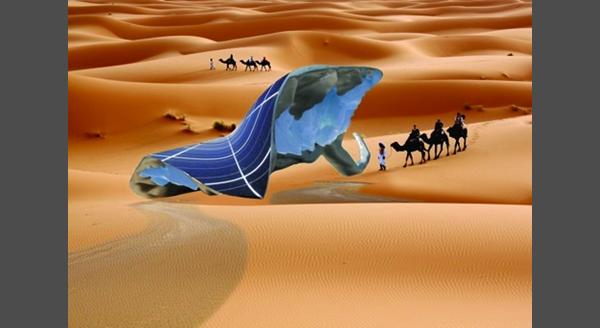
A Dutch artist is aiming to create an artificial leaf in the Sahara Desert that can grow a layer of ice on its underside.
‘Sunglacier’, as the project has been dubbed, will feature a 200m2 surface covered in photovoltaic solar cells, which will power cooling condensers on the underside of the elm leaf-shaped structure to soak up humidity from the desert air and turn it into ice.
Ap Verheggen, the artist behind the project, hopes it will encourage people to believe that the impossible is possible when it comes to dealing with climate change.
‘The project works on the basic principles of condensation. We believe the higher the humidity the more ice we can produce,’ the project’s leading engineer, Jan Alkemaide, told The Engineer.
Deserts are notoriously dry but Verheggen said: ’Our studies in Egypt have shown that the Sahara has roughly the same amount of moisture in the air as the Netherlands.’
The project is currently going through preliminary testing in the Netherlands. So far, Dutch engineers working for Cofely, a refrigeration company that makes ice rinks and custom-designed cooling units for food storage, have managed to create a 10cm-thick slab of ice on aluminium inside a shipping container that simulates desert conditions, at a temperature of 30ºC.
The unit comprises a humidifier to provide moisture and a fan pointed at the ice to simulate desert winds.
Puddles of water form underneath the Sunglacier as a result of the high temperatures, which produce meltwater that runs off the ice sheet even as it thickens.
Verheggen said that, in theory, hotter conditions can generate more ice and the plan is to eventually raise the temperature of the test unit to 50ºC.
Alkemaide explained that the Sunglacier is aiming to generate 1m2 of ice for every 10m2 of solar panels. However, this would be difficult because flexible panels are not as efficient as conventional flat panels.
He explained that to achieve the desired amount of ice production they would require an efficiency of ‘2’.
‘In other words we would need to generate 1kW of solar power for 2kW of heat transported from the surface to the atmosphere. At the moment we still require 1kW of solar power for 1kW of heat so we’re not there yet,’ he said, stressing that the existing device was only a test unit that had been ‘fairly crudely put together’.
Once the tests are completed next year, Verheggen plans to build a demonstration unit in the desert as a way of inspiring others to strive for innovative responses to the evolving circumstances of changing climates.
Source: theengineer

 Follow
Follow